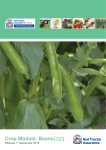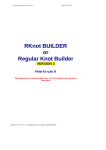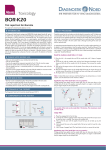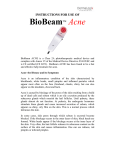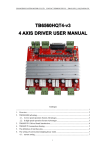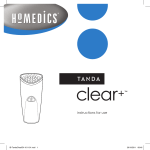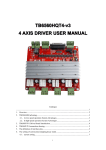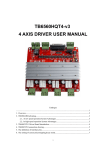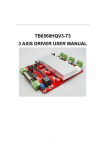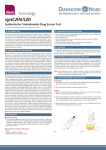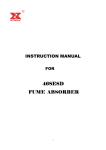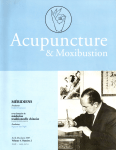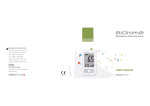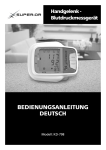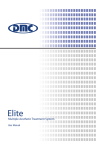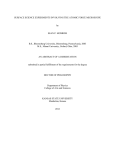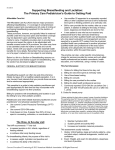Download User Manual - Diagnostik Nord
Transcript
STR -BK25 Streptococcus B Rapid Test For professional use only. INTENDED USE The identification aids in the diagnosis of diseases caused by bacteria belonging to the genus Streptococcus and provides epidemiological information on these diseases. Pathogenic streptococci are associated with infections, such as sore throat, impetigo (an infection characterized by small pustules on the skin), urinary tract infections, rheumatic fever, and kidney disease. For professional use only. The Diagnostik Nord Strep-B Rapid Test is a rapid test for the detection of group B streptococci from swabs or culture. The test’s accuracy does not depend on the organisms viability. Instead, group B strep antigen is extracted directly from the swab and identified using antibodies specific for the group B strep carbohydrate. Its analytical sensitivity is 4500 CFU/ ml of Strep B cells. SUMMARY ln pregnant women, GBS can cause bladder infections, womb infections (amnionitis, endometritis), and stillbirth. Many people carry GBS in their bodies but do not become ill. These people are considered to be „carriers.“ Adults can carry GBS in the bowel, vagina, bladder, or throat. One of every four or five pregnant women carries GBS in the rectum or vagina. A fetus may come in contact with GBS before or during birth if the mother carries GBS in the rectum or vagina. People who carry GBS typically do so temporarily -- that is, they do not become lifelong carriers of the bacteria. Approximately one of every 100 to 200 babies whose mothers carry GBS develops signs and symptoms of GBS disease. Three-fourths of the cases of GBS disease among newborns occur in the first week of life („early-onset disease“), and most of these cases are apparent a few hours after birth. Sepsis, pneumonia, and meningitis are the most common problems. Premature babies are more susceptible to GBS infection than full-term babies, but most (75%) babies who get GBS disease are full-term. GBS disease may also develop in infants 1 week to several months after birth („late-onset disease“). Meningitis is more common with late-onset GBS disease. Only about half of late-onset GBS disease among newborns comes from a mother who is a GBS carrier; the source of infection for others with late-onset GBS disease is unknown. Late-onset disease is very rare. ln adults, group B strep usually causes no symptoms. However, in rare cases, it can lead to serious bloodstream infections, urinary tract infections, skin infections, and pneumonia, especially in people with weakened immune systems and other health problems, such as diabetes. Approximately 20% of men and nonpregnant women with GBS disease die of the disease. PRINCIPLE OF THE TEST REACTION The Diagnostik Nord Strep-B Rapid Test is a sandwich immunoassay test. The test cassette contains a nitrocellulose membrane strip with an immobilized polyclone (rabbit) anti-Strep-B antibody in the test reaction zone (T). Another antibody, a goat-anti- rabbit antibody is immobilized in the control reaction zone (C) on the nitrocellulose membrane. 1OOµl to 15O µl of mixed specimen and buffer solution (containing the respective analytes, i.e. Strep-B) is added onto the gold conjugate pad. The gold conjugate pad contains a rabbit anti-Strep-B antibody which is coupled with colloidal gold. The analyte (i.e. Strep-B antigen) in the specimen react with the colloidal gold coupled anti-Strep-B antibody of the gold conjugate Pad thus forming an antibody antigen - colloidal gold complex while the liquid is moving along the membrane and transports these complexes- colloidal gold conjugate along the membrane by capillary action supported by the Absorb Pad. When the antibody - antigen - colloidal gold complexes are transported across the membrane and reach the respective immobilized rabbit anti-Strep-B antibody on the membrane, they are trapped and will form a sandwich complex consisting of: immobilized antibody - antigen (analyte) - antibody - colloidal gold. Only when the applied specimen sample contains a certain concentration of Strep-B, the formation of this sandwich complex will result in a visible purple color band in the respective test region of the membrane. ln case there are not Strep-B in the specimen sample, the test region of the membrane will remain colorless (no test band visible). The liquid colloidal gold conjugate continues to move to the control area (C) band on the nitrocellulose membrane. There, this conjugate will form a complex with the immobilized anti rabbit antibody on the membrane resulting in the formation of a purple colored control (C) test band. This indicates that the test has been performed correctly. 5. Swab : with polyester tip: Dalian Rongbang Medical Healthy Devices Co., Ltd Maoyingzi Hamlet Dalianwan Town; Gangjingzi District, 116113, P.R.C (EC Representant: YAOTONG S.L., Ausias Marc, 92-98, esc. is in accordance with Directive 93/42/EEC) 6. Test Tube 7. External positive and negative control STORAGE AND STABILITY The Diagnostik Nord Strep-B Testkit has to be stored at room temperature 4-30°C (40-86°F). The test device is sensitive to humidity as well as to heat. Perform the test immediately after removing the test device from the foil pouch. Do not use it beyond the expiration date. Reagents should always be sealed to prevent contamination and evaporation. WARNINGS 1. 2. 3. 4. 5. 6. For in vitro diagnostic use only. Do not eat or smoke while handling specimens. Wear protective gloves while handling specimens. Wash hands thoroughly afterwards. Avoid splashing or aerosol formation. Clean up spills thoroughly using an appropriate disinfectant. Decontaminate and dispose of all specimens, reaction kits and potentially contaminated materials, as if they were infectious waste, in a biohazard container. 7. Do not use the test kit if the pouch is damaged or the seal is broken. SPECIMEN COLLECTION 1. Swab the lower vagina (vaginal introitus), followed by the rectum (i.e., insert swab through the anal sphincter) using the same swab or two different swabs. 2. Do not use swabs with cotton or calcium alginate tips or wooden shafts. Do not use swabs impregnated with charcoal or transport media containing agar gelatin. 3. If a sample is to be stored prior to testing, it should be placed in a dry test tube, covered, and refrigerated. All samples should be tested within 5 days after collection. 4. If specimen was refrigerated, it should be brought to room temperature before testing. Avoid thawing and freezing the specimens many times before use. SPECIMEN PREPARATION 1. Put 12 drops Extraction Buffer in the test tube. 2. Place the specimen swab in the tube and swirl it vigorously to mix the reagents for about 15 seconds. Then incubate the mixture at room temperature for 10 minutes with the swab in the tube. 3. Swirl the swab vigorously for 15 seconds, then expunge as much liquid as possible from the swab by pressing and rotating the fiber portion against the wall of the tube. Discard the swab. Mix the contents of the tube by gentle swirling. The mixture is ready for testing. 12 Strep B test device Instructions Disposable sample dropper Extraction Buffer 3 9 MATERIALS PROVIDED 1. 2. 3. 4. 0197 Centre. 3a, Barcelona, 08013, Spain) CE0197 (Additional material 1. 2. 3. 6 4. PROCEDURE OF THE TEST LIMITATIONS OF THE TEST 1.Remove the test disk from the foil packet, and place it on a flat, dry surface. 2.Holding the sample dropper above the test disk, squeeze a total of 3 drops of the mixed specimen into the sample well. Wait until each drop is absorbed, before adding additional drops. If after the first drop, the drop is not absorbed within 30 seconds, follow it up with 2 buffer drops directly from the buffer bottle, and require no additional specimen. 3.As the test begins to work, you will see purple color move across the Result Window in the center of the test disk. 4.Interpret test results at 10 minutes. Do not interpret test after 10 minutes. Caution: The above interpretation time is based on reading the test results at room temperature of 15 to 30 °C. If your room temperature is significantly lower than 15 °C, then the interpretation time should be properly increased. 12 3 9 6 StepB 1. 2. PROCEDURE FOR EXTERNAL QUALITY CONTROL TESTING Although the Test is very accurate in detecting Strep B, a low incidence of false results can occur. Other clinically available tests are required if questionable results are to be obtained. As is true with any diagnostic procedure, the physician should evaluate data obtained by the use of this kit in light of other clinical information, including culture, if results are inconsistent with clinical symptoms. The Diagnostik Nord Strep-B Rapid Test is a qualitative assay. The amount of Strep B present in the specimen cannot be estimated by the assay. The assay results distinguish positive from negative samples. A positive result indicates the sample contains Strep B above the cut-off concentration. As with all diagnostic tests, a definitive clinical diagnosis should not be based on the results of a single test, but should only be made by the physician after all clinical and laboratory findings have been evaluated. PERFORMANCE EVALUATION STUDIES Sensitivity testing of the Diagnostik Nord Strep-B Rapid Test in comparison to LlM + SBM Broth Culture: For this study, vaginal specimens from 427 pregnant women are taken. All pregnancies are within the range of 35 to 37 weeks, and all are known to be healthy pregnancies at the time of sample collections. Two virginal swabs (specimen) are taken from each woman one for culture and one to perform the Diagnostik Nord Strep-B rapid test Conclusion: The sensitivity of the Diagnostik Nord Strep-B Rapid Test is 88.8% (128/144) and the specificity is 97.8% (277/283) when compared to the golden standard of LIM+SBM culture method. Sensitivity testing of the Diagnostik Nord Strep-B Rapid Test in comparison to ELISA: A double blind study is carried out with 90 pregnant women about 35 weeks into their pregnancy. Two virginal swabs (specimen) are taken from each woman, specimen are coded so that a double blind study can be carried out. Conclusion: The Diagnostik Nord Strep-B Rapid Test has a relative sensitivity of 97.4% and a relative specificity of 98% with a commercially available ELISA Strep B Test Kit. External controls maybe performed with the provided positive and negative controls. External controls may be tested when opening a new test kit. 1. Add 2 to 3 drops of positive (provided) or negative (provided) control into the sample well of the test device. Interpret test results at 10 minutes. Positive result should develop within 10 minutes Do not interpret test results after 10 minutes. 2.Please see the previous section of “Interpretation of the Test” for interpreting the test results. INTERPRETATION OF THE TEST 1. A color band will appear at the left section of the result window to show that the test is working properly. This band is the Control Band. 2.The right section of the result window indicates the test results. If another color band appears at the right section of the result window, this band is Test Band. Cross Reactivity The following organisms did not cross react with the Strep-B rapid test: Strep-A, Camplyobacter fetus, Campylobacter jejunii, E. coli INTERFERENCE STUDY The following substances at the specified concentrations have not shown to interfere with the Strep-B rapid test. Acetamiophen, 20 mg/dl; Acetyl salicylic Acid, 20 mg/dl; Ascorbic Acid, 20 mg/dl; Atropine, 20 mg/dl; Bilirubin, 60 mg/dl; Caffeine, 20 mg/dl; Creatinine, 20 mg/ dl; Gentesic Acid, 20 mg/dl; Glucose, 2000 mg/dl; Hemoglobin, 500 mg/dl; Ketones, 40 mg/dl; Mestranol, 3 mg/dl; Nitrite, 20 mg/dl; Penicillin, 40,000 U/dl; Sodium Heparin, 3 mg/dl; Lithium Heparin, 3 mg/dl. REFERENCES POSITIVE NEGATIVE TWO COLOR BANDS The presence of two color bands (“T” band and “C” band) within the result window regardless of which band appears first indicates a positive result (Figure 2). Note: Generally, the higher the analyte level in the specimen, the stronger the “T” band color will be. When the specimen analyte level is close to but still within the sensitivity limit of the test, the color of the “T” band will be very faint. ONE COLOR BAND The presence of only one purple color band within the result window (“C” band) indicates a negative result. 1.Brady K, Duff P, Schilhab JC, et al, “Reliability of a Rapid Latex Fixation Test for Detecting Group B Streptococci in the Genital Tract of Parturients at Term,” Obstet Gynecol, 1989, 73(4):678-81. 2.Stiller RJ, Blair E, Clark P, et al, “Rapid Detection of Vaginal Colonization With Group B Streptococci by Means of Latex Agglutination,” Am J Obstet Gynecol, 1989, 160(3): 566-8. SYMBOLS Content n For in vitro diagnostic use only Lot number For single use only Expiry date 30° INVALID After performing the test and no purple color “C” band is visible within the result window, this result is considered invalid. The directions may not have been followed correctly or the test may have deteriorated. It is recommended that the specimen be re-tested. Note: A positive result will not change once you have established your answer at 10 minutes. However, in order to prevent any incorrect results, the test result should not be interpreted after 10 minutes. Carefully read package insert Store at room temperature 4° Rev.: 13.03.2015 (JM) ersetzt: 01.09.2012 (JM) HERSTELLER Diagnostik Nord GmbH Mecklenburgstr. 97 19053 Schwerin Germany Telefon: Fax: E-Mail: Internet: +49 (0)385/208409-0 +49 (0)385/208409-29 [email protected] www.diagnostik-nord.de


